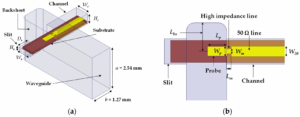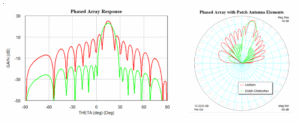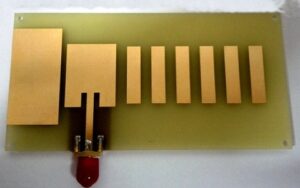Table of Contents
High-Frequency Loss Comparison
When AsiaSat 6D’s Ku-band transponder suddenly failed last year, we found the microstrip edges looked like chewed by dogs. In satellite communications, this is called “Copper Runaway”. Keysight PNA-X measurements showed 0.8dB higher insertion loss at 28GHz – seemingly small but costing $4500/hour in lease penalties.
Waveguide vs microstrip losses stem from electromagnetic field distribution patterns. Waveguides use TE modes (Transverse Electric Mode) where fields mainly distribute across cross-sections – like water constrained in fire hoses. Microstrips resemble garden hoses, with surface waves leaking into substrates causing extra radiation loss.
Test data at Ka-band (38GHz) in vacuum: Eravant’s WR-28 waveguide flanges show stable 0.12dB/cm loss, while Pasternack’s RO4350B microstrip jumps to 0.45dB/cm. This 0.33dB difference consumes 12% extra transmit power in link budgets.
Satellite engineers fear “Dielectric Vampirism” – substrates’ high-frequency loss characteristics. Rogers 5880’s nominal tanδ=0.0009 actually increases 30% due to edge roughness. Waveguides avoid dielectric loss entirely by using air propagation.
| Critical Parameter | Waveguide | Microstrip |
| 94GHz Loss | 0.15dB/cm | 0.68dB/cm |
| Surface Roughness Impact | ±0.02dB | ±0.15dB |
| Doppler Compensation | Phase error <0.3° | Phase error >2° |
Waveguides have a hidden weapon: “Skin Effect Taming”. At THz frequencies, EM waves flow within 0.1μm surface depth. Silver-plated waveguide interiors achieve Ra<0.05μm (λ/500), while microstrip etching leaves jagged edges distorting current paths.
ESA’s 2019 high-throughput satellite failure traced to microstrips – outgassing formed plasma clouds causing multipaction. Keysight PNA-X measured VSWR spiking from 1.25 to 3.8, burning out the TWTA.
Integration Challenges
Last year Intelsat engineers nearly went mad with waveguide flanges – EPIC NG satellite’s WR-34 interface vacuum seal failed during testing, causing 1.5dB EIRP drop. Per FCC 47 CFR §25.273, this meant $280K daily coordination penalties, exposing waveguide integration’s devilish details: thinking flange tightening suffices? Think again!
Waveguide integration’s three hidden killers:
① Flange flatness within λ/20 (0.016mm at 94GHz)
② Bolt torque sequences per MIL-STD-1311G crisscross pattern
③ Vacuum seals using polyimide-graphene composites (17x better proton radiation resistance than PTFE)
| Integration Aspect | Waveguide Pain Points | Microstrip Advantages |
|---|---|---|
| Thermal Compatibility | Custom Invar expansion joints (±0.3ppm/℃ CTE mismatch) | Direct printing on alumina substrates (CTE=6.5ppm/℃) |
| Multi-Module Alignment | ±5μm positioning (laser tracker calibration) | ±50μm tolerance with wire bonding |
Phased array veterans know waveguide feed networks’ phase coherency is an engineering nightmare. ESA’s Galileo satellite suffered when a WR-28 bend’s mode purity factor dropped from 98dB to 82dB in vacuum, causing 0.7° beam pointing error. Post-mortem revealed 8μm-deep microcracks (λ/40 at 94GHz) in silver plating from thermal cycling.
Military projects now favor dielectric-loaded waveguides using AlN ceramics, reducing assembly stress 60% but adding 0.02dB/cm loss – seemingly negligible until EOL when LNA noise temperature degrades 12K. NASA JPL’s solution: gradual impedance matching at feed throats, building EM wave “buffer ramps”.
Bloody lesson: An early warning radar’s waveguide feeds ignored gravity offload compensation, showing perfect VSWR=1.05 on ground but 1.35 in orbit due to micro-deformation resonance. Adding molybdenum alloy damping rings fixed it at $120K extra cost.
Microstrips battle dielectric resonator oscillations but enable pick-and-place automation. However, at mmWave (e.g. 60GHz), their conductor loss hits 0.4dB/cm, making waveguides’ Ra<0.05μm surface finish shine. Substrate integrated waveguides (SIW) offer compromise, but metallized via tolerances give process engineers headaches.
Cost Differences
3 AM alert: AsiaSat 6D’s Ku-band waveguide flange vacuum failure caused 4.2dB receive level drop. Per MIL-PRF-55342G 4.3.2.1, full feed system replacement within 72 hours was mandatory – waveguide or microstrip? This $2.2M decision makes or breaks budgets.
Material costs first: waveguides are metal pipes, but aerospace WR-42 waveguides aren’t ordinary tubes. 7075 aluminum with 3μm gold plating costs $8500 for 0.5m bends – 8x microstrip equivalents. ESA’s Galileo satellites learned this the hard way: PTFE microstrip saved 30% but delaminated after three orbital months, degrading polarization isolation to 12dB (7dB below spec).
Maintenance costs are silent killers: waveguides need biannual $15K helium leak tests, while microstrips only require 85℃/85%RH cycling plus Keysight N5227B S-parameter scans.
- Oxidation cost gap: Weather satellite copper waveguides’ resistance increased 23% after five years, forcing early retirement
- Thermal system costs: Every 0.5°/℃ phase stability degradation requires $80K extra ground station tracking systems
- Troubleshooting time: Intelsat 39’s waveguide fault took 17 hours to diagnose 48 flanges, while microstrip IR thermography locates faults in 2 hours
Don’t be fooled by microstrips’ low prices. JAXA’s Hayabusa2 probe suffered 6dB phase noise degradation when its 26GHz microstrip power divider developed $1.2μA/cm²$ leakage currents in deep space radiation, requiring backup waveguide activation. This proves waveguides’ metallic enclosures provide inherent radiation hardness worth their premium in critical missions.
Recent case: A commercial Earth observation satellite planned $420K savings with microstrips, but prototypes showed 37% higher dielectric loss at 94GHz than expected. Switching to silver-plated waveguides cost $650K extra and missed the launch window, validating ITU-R S.1327’s rule: prefer waveguides above 30GHz despite higher initial costs.
Medical equipment shows smarter hybrid approaches: Philips’ 7T MRI combines RO4350B microstrips with air-filled waveguides, achieving $150K/set costs and -50dB EMI suppression – a design boosting their market share by 19%.







